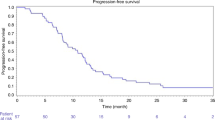Abstract
Purpose
To evaluate the predictors of toxicity of drug-eluting beads loaded with irinotecan (DEBIRI) in the treatment of hepatic malignancies.
Materials and Methods
A total of 330 patients were enrolled in a prospective, open-label, multicenter, multinational, single-arm study administering two types of drug-eluting beads (DEBIRI and drug-eluting beads loaded with doxorubicin). Complications were graded by Cancer Therapy Evaluation Program’s Common Terminology Criteria for Adverse Events (CTCAE) version 3.0. All events requiring additional physician treatment or requiring extended hospital stay or readmission within 30 days were included.
Results
A total of 109 patients received 187 DEBIRI treatments (range 1 to 5 per patient). The most common histology was metastatic colorectal cancer in 76% of patients, cholangiocarcinoma in 7% of patients, and other metastatic disease in 17% of patients. There were 35 patients (19%) with irinotecan treatments who sustained 158 treatment-related adverse events, with the median CTCAE event grade being CTCAE grade 2 (range 1 to 5). The most common adverse events were postembolic symptoms (42%). Multivariate analysis identified pretreatment and treatment-related risk factors as follows: lack of pretreatment with hepatic arterial lidocaine (p = 0.005), ≥3 treatments (p = 0.05), achievement of complete stasis (p = 0.04), treatment with >100 mg DEBIRI in 1 treatment (p = 0.03), and bilirubin >2.0 μg/dl with >50% liver involvement (p = 0.05). These factors were predictive of adverse events and significantly greater hospital length of stay.
Conclusions
DEBIRI is safe when appropriate technique and treatment are used. Adverse events can be predicted based on pretreatment- and treatment-related factors, and their occurrence can become part of the informed consent process. Continued standardization of this treatment will lead to fewer adverse events and improved patient quality of life.

Similar content being viewed by others
References
Scoggins CR, Meszoely IM, Blanke CD et al (1999) Nonoperative management of primary colorectal cancer in patients with stage IV disease. Ann Surg Oncol 6:651–657
Martin RC, Robbins K, Tomalty D et al (2009) Transarterial chemoembolisation (TACE) using irinotecan-loaded beads for the treatment of unresectable metastases to the liver in patients with colorectal cancer: an interim report. World J Surg Oncol 7:80
Aliberti C, Tilli M, Benea G et al (2006) Trans-arterial chemoembolization (TACE) of liver metastases from colorectal cancer using irinotecan-eluting beads: Preliminary results. Anticancer Res 26:3793–3795
Fiorentini G, Aliberti C, Turrisi G et al (2007) Intraarterial hepatic chemoembolization of liver metastases from colorectal cancer adopting irinotecan-eluting beads: results of a phase II clinical study. In Vivo 21:1085–1091
Tang Y, Taylor RR, Gonzalez MV et al (2006) Evaluation of irinotecan drug-eluting beads: a new drug-device combination product for the chemoembolization of hepatic metastases. J Control Release 116:e55–e56
Taylor RR, Tang Y, Gonzalez MV et al (2007) Irinotecan drug eluting beads for use in chemoembolization: in vitro and in vivo evaluation of drug release properties. Eur J Pharm Sci 30:7–14
Xu Y, Villalona-Calero MA (2002) Irinotecan: mechanisms of tumor resistance and novel strategies for modulating its activity. Ann Oncol 13:1841–1851
Hecht JR (1998) Gastrointestinal toxicity or irinotecan. Oncology (Williston Park) 12:72–78
Slichenmyer WJ, Rowinsky EK, Donehower RC et al (1993) The current status of camptothecin analogues as antitumor agents. J Natl Cancer Inst 85:271–291
Potmesil M (1994) Camptothecins: from bench research to hospital wards. Cancer Res 54:1431–1439
Hsiang YH, Hertzberg R, Hecht S et al (1985) Camptothecin induces protein-linked DNA breaks via mammalian DNA topoisomerase I. J Biol Chem 260:14873–14878
Hsiang YH, Liu LF, Wall ME et al (1989) DNA topoisomerase I-mediated DNA cleavage and cytotoxicity of camptothecin analogues. Cancer Res 49:4385–4389
Jaxel C, Kohn KW, Wani MC et al (1989) Structure-activity study of the actions of camptothecin derivatives on mammalian topoisomerase I: evidence for a specific receptor site and a relation to antitumor activity. Cancer Res 49:1465–1469
Martin RC, Joshi J, Robbins K et al (2009) Transarterial chemoembolization of metastatic colorectal carcinoma with drug-eluting beads, irinotecan (DEBIRI): multi-institutional registry. J Oncol 2009:539–795
Lewis AL, Gonzalez MV, Lloyd AW et al (2006) DC bead: in vitro characterization of a drug-delivery device for transarterial chemoembolization. J Vasc Interv Radiol 17:335–342
Kaiser J, Thiesen J, Kramer I (2009) Stability of irinotecan-loaded drug eluting beads (DC BeadTM) used for transarterial chemoembolisation. J Oncol Pharm Pract 6:53–61
Morise Z, Sugioka A, Kato R et al (2006) Transarterial chemoembolization with degradable starch microspheres, irinotecan, and mitomycin-C in patients with liver metastases. J Gastrointest Surg 10:249–258
Mi Z, Burke TG (1994) Differential interactions of camptothecin lactone and carboxylate forms with human blood components. Biochemistry 33:10325–10336
Mathijssen RH, van Alphen RJ, Verweij J et al (2001) Clinical pharmacokinetics and metabolism of irinotecan (CPT-11). Clin Cancer Res 7:2182–2194
Kunimoto T, Nitta K, Tanaka T et al (1987) Antitumor activity of 7-ethyl-10-[4-(1-piperidino)-1-piperidino]carbonyloxy-camptothec, in a novel water-soluble derivative of camptothecin, against murine tumors. Cancer Res 47:5944–5947
Kawato Y, Aonuma M, Hirota Y et al (1991) Intracellular roles of SN-38, a metabolite of the camptothecin derivative CPT-11, in the antitumor effect of CPT-11. Cancer Res 51:4187–4191
Burke TG, Munshi CB, Mi Z et al (1995) The important role of albumin in determining the relative human blood stabilities of the camptothecin anticancer drugs. J Pharm Sci 84:518–519
Acknowledgment
Supported by an Unrestricted Educational Grant from Biocompatibles. RCGM: Consultant Biocompatibles.
Conflict of interest
The authors declare that they have no conflict of interest.
Author information
Authors and Affiliations
Corresponding author
Rights and permissions
About this article
Cite this article
Martin, R.C.G., Howard, J., Tomalty, D. et al. Toxicity of Irinotecan-Eluting Beads in the Treatment of Hepatic Malignancies: Results of a Multi-Institutional Registry. Cardiovasc Intervent Radiol 33, 960–966 (2010). https://doi.org/10.1007/s00270-010-9937-4
Received:
Accepted:
Published:
Issue Date:
DOI: https://doi.org/10.1007/s00270-010-9937-4




